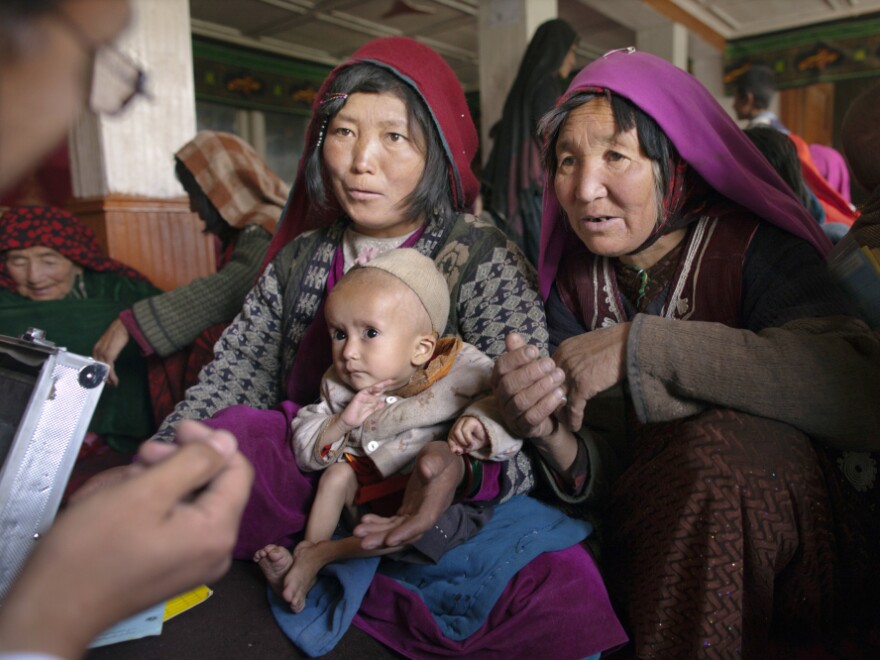A U.S.-sponsored mortality survey released last year announced huge improvements in health across Afghanistan. But the gains are so great that experts are still arguing about whether it's correct.
During three decades of war, Afghanistan remained a black hole of health information. The few mortality studies looked at a small slice of the population and then extrapolated.
We were all surprised. That's what led to additional review and much more analysis.
The numbers were horrific. Life expectancy in 2004 was measured at just 42 years; 25 percent of children did not survive until the age of 5. For every 100,000 deliveries, a staggering 1,600 women died in childbirth, the second-worst rate in the world.
Enter last year's $5 million Afghanistan Mortality Survey, which was funded by the U.S. Agency for International Development with a contribution from the U.N. Children's Fund. Officials say the new survey provides the most accurate snapshot ever of health in Afghanistan — and it delivered shockingly good news.
Afghan surveyors in all 34 provinces brought back data suggesting that life expectancy at birth is now 62 years. Child mortality under age 5 dropped to 10 percent. Of 100,000 live births, the maternal mortality number was down to 327.
"We were all surprised," says Susan Brock, health adviser with USAID in Kabul. "That's what led to additional review and much more analysis."
Brock says it was such an improvement compared with previous surveys that USAID delayed the release to crunch the numbers again. Last November, after months of re-examining results and meetings of technical experts in Dubai and in Washington, the agency confirmed the findings and released the survey with great fanfare.
But believing the new numbers are accurate probably means accepting that the old numbers were way off, which makes it impossible to say exactly how much health has really improved. It's unlikely that both the old life expectancy of 42 years and the new estimate of 62 years are correct.
'Huge Question Marks'

Some experts who worked on the survey still think it shows too much of a leap forward to be credible. Dr. Kenneth Hill, a Harvard University demographer and technical adviser on the survey, says there are too many anomalies.
"If the results had come out closer to expectations, they would have been hugely valuable, I think," Hill says. "But because there are still huge question marks hanging over the estimates, I'm not sure there is an enormous value in the data."
The survey divided Afghanistan into three regions: north, center and south. In many findings, the southern zone is excluded, because security made it impossible to conduct polling. Cultural taboos about discussing female family members meant that the birthrate of female children was underreported, and that's also likely true of infant mortality.
The survey clearly and honestly explains these facts, and USAID says that statisticians accounted for many such factors. But Hill says he suspects the raw data is off.
"Conditions for data collection are desperately difficult," he says. "Knocking on someone's door and asking them details about their children and their household is not something most people would want to do."
Three of the six experts on the survey's technical advisory group told NPR they still have doubts, even after the extra analysis. That includes Julia Hussein, of Aberdeen University.
"You've got to match what you know in terms of evidence with what you see with your eyes," says Hussein, who has worked on maternal mortality in Afghanistan since the 1990s.
"My instinctive reaction to figures reported in the survey — I just find them unbelievable, knowing what sort of care is available in Afghanistan," she says.
Undeniable Progress
You've got to match what you know in terms of evidence with what you see with your eyes. My instinctive reaction to figures reported in the survey, I just find them unbelievable, knowing what sort of care is available in Afghanistan.
But defenders of the study say people can't believe the numbers because they've become accustomed to thinking of Afghanistan as hopeless.
Dr. Mohammad Rasooly, with the Afghan Ministry of Public Health, was the lead technician from the Afghan side of the survey. He says health care in his country is improving dramatically, and in many different ways.
"If we consider only the example of midwives, 10 years back we had only 400 midwives at the national level. So, today we have more than 3,000. This is very important for maternal care," Rasooly says.
Now, new paved roads mean that a journey to one of the thousands of newly built clinics takes hours instead of days in rural areas, says Rasooly. Widespread mobile phones have helped save the lives of people who in the past had no way to call for help. And there is little doubt that women have much more access to health care.
Maternal mortality is notoriously hard to measure, and the new figure of 327 maternal deaths per 100,000 births has a margin of error that could make it much higher. It could be nearer 500, says Rasooly, but it's certainly not 1,600, which is progress.
Need For Aid Still Acute
It's not about knowing the exact number, says Ken Yamashita, USAID mission director in Afghanistan.
"We're quite confident of the numbers. In the end, it's a survey, so any survey has an error margin," he says.
Yamashita says the new mortality survey is the best ever done in Afghanistan.
"What it represents is a more representative survey on the one hand, and two, a very real improvement in health," he says.
The only way to know will be to conduct more surveys a few years down the road, at the same comprehensive standard, says Yamashita. He adds that even the new, more encouraging numbers show that Afghanistan is still desperately in need of international aid to help improve the health of its people.
Copyright 2021 NPR. To see more, visit https://www.npr.org.




